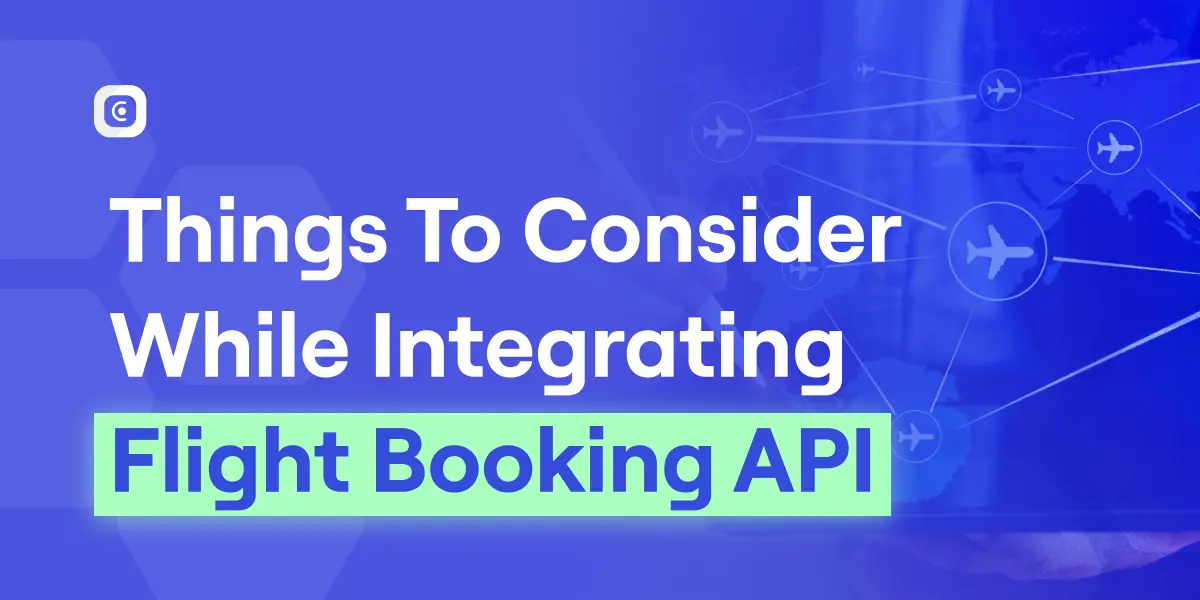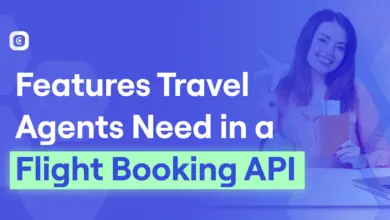Things to Consider for Seamless Flight Booking API Integration in your Travel Website

When creating a competing travel site, perhaps the most important choice is using the proper Flight Booking API. The right Flight API integration boosts your platform by providing access to numerous airlines and their functionalities such as real-time availability, pricing, and booking. Regardless if your goal is to enable an all-encompassing flight reservation API or just enhance your ticketing operations, there are important technical considerations you need to think of. In this blog, we will discuss how to integrate a flight booking API effectively and the key factors to consider for a seamless user experience.
Yes, it’s flight booking APIs. This extension has allowed the B2B and B2C businesses to enrich their customers with instant access to accurate flight data, seamless bookings, and personalized experiences. Gone are the days, when customers had to experience a significant price hike since their last search.
However, how to pick the best flight API integration service with so many options out there? To help you with the same, this guide will discuss everything you need to consider while integrating flight booking API into your travel website. Stick till the end, as we’ll also discuss how OneClick can help you make an informed decision and experience tremendous growth.
Why Real-Time Data is Crucial for Flight Booking API Integration
The most important characteristic of a flight booking engine is its ability to provide information in real-time. Imagine a situation where the user gets notified about the change in the departure time at the last minute. Or to get stuck with outdated airline schedules and prices while booking a flight.
That’s not it, inaccurate data further leads to:
- Lost Opportunities: Price discrepancies or false availability leads the user to leave the booking midway.
- Operational Chaos: Manual rebooking during delays or cancellations limits resources and gives a hard time to time.
- Reputational Damage: Poorly managed services lead to bad publicity, especially in the internet era where everyone shares everything online with just one click.
To avoid such scenarios, it’s important to prevent users from getting frustrated and losing them to competitors. As a result, TMCs, DMCs, and tour operators have to ensure that they are providing the best possible services to their customers.
By syncing live data from airlines and Global Distribution Systems (GDS), travel agents can ensure that the users get access to accurate prices, schedules, and seat availability. From our experience, many of our clients have experienced a massive spike in their travel websites and reduced complaints by integrating flight booking API.
Plus if you want to read more in detail about the benefits of Flight Booking API, then you must check out our recent blog published on this topic.

How to Choose the Best Flight Booking API Provider
While it sounds very appealing, flight booking API integration should be carried out very carefully. Not all APIs present in the market are optimized to streamline the operations of your website. One wrong move and everything goes down the drain.
But you can simply your decision by prioritizing the following factors.
- Comprehensive Documentation: Look for clear guides, code samples, and sandbox environments to ensure the reliability of the API.
- Reliability & Uptime: Choose airline API integration providers with ≥99.9% uptime and SLAs for technical support.
- Global Coverage: Ensure access to major airlines, budget carriers, and multi-GDS networks like Amadeus or Sabre.
- Pricing Models: Avoid hidden fees by carefully analyzing pay-per-request, subscription models, or revenue-share structures.
- Advanced Features: Seek APIs with sustainability features, like carbon footprint calculators, to appeal to eco-conscious travelers.
Key Steps to Integrate Flight Booking API Successfully
Once you’ve verified all the factors discussed above, you can move ahead with airline API integration into your B2B flight booking portal.
1. Acquiring API Access
Once you’ve acquired the rights to a top flight booking API, the real work starts. You integrate the API onto your portal, you will have to register your provider to receive authentication credentials. Be very careful while undertaking this transition, and use API tokens to protect your sensitive information.
2. Understanding API Documentation
While the flight booking API integration is underway, study the API documentation and clear your doubts. You must focus on endpoints like flight search and booking features to check their parameters and response formats. While you’re at it, also test the rate limits of the API to avoid server overloading.
3. Testing the API Integration
To ensure your travel website is risk-free for all the customers simulate booking in real-time. This will give you a brief idea of how your travel portal is dealing with issues like cancellations and payment failures. This is called sandbox testing.
Another crucial aspect you should consider is error handling. Make sure to plan for HTTP error status codes like 429, which indicates rate limits, and 500, which signals server errors. Having a strategy will help you respond effectively in case of an emergency.
4. Customizing API Content & User Experience
It goes without saying, but your travel website should be easy to navigate for all users. The flight booking API integration should not compromise with UI/UX experience of your portal. Tailor your portal with search filters, themes, and booking models to make it stand out from the competitors.
Additionally, the API should boast multi-language and multi-currency support for global reach. This comes in handy when you wish to cater to an international audience as they can navigate your portal in their native language and can convert values in real time.
5. Ensuring Compliance & Data Security
Security should be your number one priority. Make sure that the flight booking API is complies to both CCPA and GDPR international standards. These parameters encrypt user data and obtain explicit consent for data collection. Additionally, it’s better if the API provider is partnered with PCI-DSS for secure payment processing.
6. Monitoring & Maintenance
Even when the flight API integration has been successfully completed, keep a continuous track of latency, error rates, and uptime. This will help you audit the performance of your portal post-API integration. You can even request the providers to patch you up with the latest updates to ensure the optimal performance of your portal.

Unique API Features to Enhance Your Travel Booking Platform
Now here’s something extra for you. Enrich your custom flight booking engine with not-so-common yet important features. This will help you stand out among the competitors and help to foster stronger relationships with your customers.

AI-Powered Personalization
Develop a customized travel portal that suggests relevant hotels, car rentals, and activities to the customers. Such customized packages will help you generate more revenue while simplifying the booking of the user. OneClick can help you develop a custom flight booking portal that provides end-to-end booking services like flights+car rentals+cruise+hotel.
Blockchain Transparency
Once the user has selected the preferred airline, seats, and ancillary services, give a detailed breakdown of the fare. Transparent pricing helps in building trust and loyalty. Right in the payments tab, you can include charges for every selected service like baggage fees
Crisis Management
Optimize your flight booking software to assist users in case of natural emergencies like weather storms, or strikes. Develop your portal to automatically rebook the customers in the next flight available.
Sustainability Integration
Since many customers prioritize eco-friendly journeys, provide a filter to select such airlines as well. With this integration, you can enable the users to choose the airlines that display carbon footprints and other eco-friendly offsets.
Loyalty Program Syncing
To reward your loyal customers, try to include programs that automatically credit some points into their wallets. In the future, such customers will be able to book the next flight at a much more affordable price. This will not only improve customer satisfaction but also attract new users.
Best Practices for Smooth Airline API Integration
Now here are some good practices that can help you streamline the operations and keep your customers happy for a long time.
- Implement a robust error-handling mechanism that can help you mitigate unwanted issues with minimum hassle.
- Optimize API calls to deliver quick results and improve loading speed.
- Reduce the server load by regularly caching accessed data as it will keep your operations running smoothly during peak season.
- Ensure the flight booking app is compatible with mobile phones too as a major chunk of the users book flights on the go.
- Set up failover mechanisms to handle downtime so the customer experience remains unaffected.
Why OneClick Stands Out in Flight Booking API Integration
While many providers offer basic flight data, OneClick delivers a holistic solution tailored for modern travel businesses. Take a brief look through the flight booking API features provided by OneClick for your travel portal.
- Calendar
- Discount Management
- Online Check-In
- Reports
- Email Automation
- Currency Exchange Management
- Brand Management
- Multiple Language Capability
- Secure Processing
- Revenue Management
- Booking Reminders
- Flexible Search
- Live Access
- Affiliate & Distribution Network
- User Management
- Front Office

Seamless Flight API Integration: The Key to a Future-Ready Travel Business
This discussion allows us to see that Flight API Integration is important within the context of remaining competitive in this ever-changing industry. Selecting the right Flight Booking API allows you to transform your travel website into a go-to, easy-to-navigate travel website which provides hassle-free flight reservation API services.
Success hinges on real-time information, data security, cutting-edge technology such as AI, and sustainable practices. If you are wondering how to integrate Flight Booking API efficiently, collaboration with a more relative provider such as OneClick ensures that you are well-prepared to embrace the newest tech innovations and deliver excellent customer service. So, don’t hesitate, integrate Flight Booking API now and enhance your platform’s efficiency.
And if in case you are interested to know about how much does it cost to create a how much does it cost to Build a Flight Booking Website, then you must check out our recent blog post on this topic.
FAQs
Top flight booking API providers like OneClick offer localization features, but if you’re looking to cater to a niche audience you may need a custom solution developed.
Some of the most common errors in flight booking API travel portals include authentication errors, API downtime, slow response times, and complex data handling.
Professional assistance to developers is only excluded when the API providers offer plug-and-play white-label solutions. In every other case developer assistance is a must.
Yes, multi-API integration allows broader inventory access and better pricing options for users.
If not optimized, excessive API calls can slow down performance. Caching and efficient data retrieval can mitigate this.


